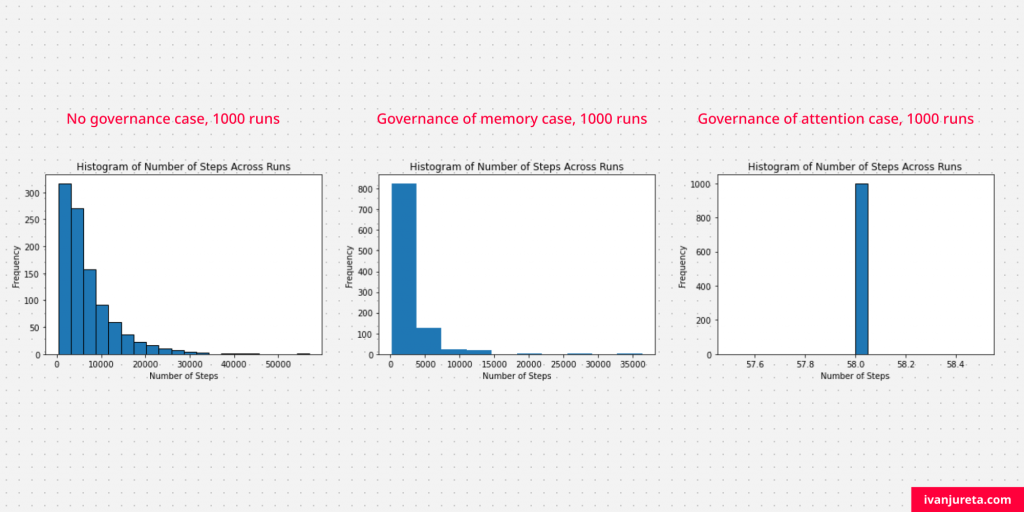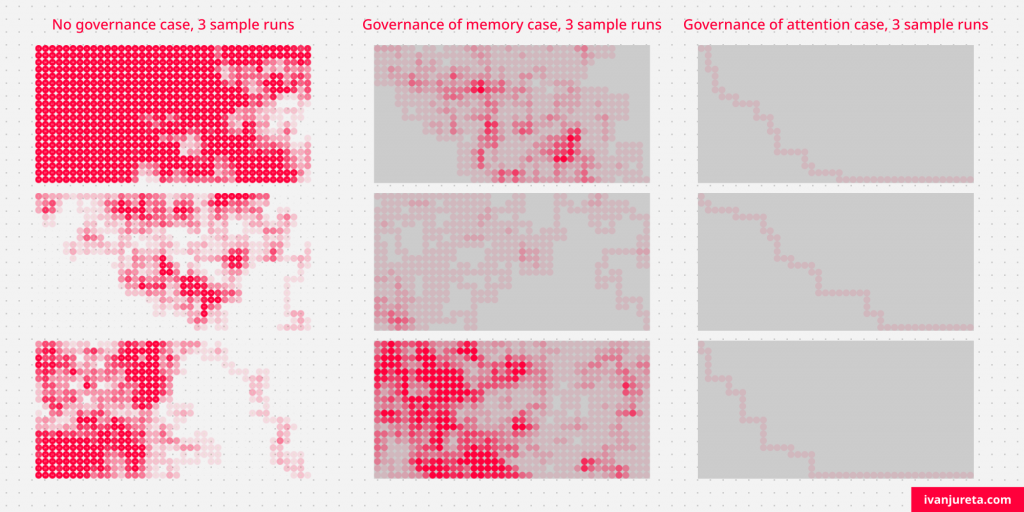How Can Governance of Attention and Memory Change Choice?
Three decision governance strategies are compared in terms of how they influence the ability of an agent to reach their goal in a simple problem. The strategies are:
- No decision governance: The agent is assumed to choose randomly between options, and they can see all the options in the problem, i.e., they have perfect information at each step, but have incomplete information about how steps lead to their goal. The agent does not remember their choices, and each step is new.
- Governance of memory: Decision governance is introduced to ensure agent’s choices are logged and the agent is discouraged from repeating them, that is, governance compensates for the agent’s absence of memory (memory in the sense that the agent would remember if they were in the same place twice).
- Governance of attention: Decision governance is such that it directs the agent’s attention at every step to the option that is closest to their goal.
This text is part of the series on decision governance. Decision Governance is concerned with how to improve the quality of decisions by changing the context, process, data, and tools (including AI) used to make decisions. Understanding decision governance empowers decision makers and decision stakeholders to improve how they make decisions with others. Start with “What is Decision Governance?” and find all texts on decision governance here.
The key difference between the governance of memory and of attention, as outlined above, is that you can implement governance of memory even if you do not know the exact goal of the agent (and so cannot guide them to it). Instead, you can only implement governance of attention – at least in the sense this has in the present text – without knowing the goal they are aiming to achieve.
Let’s consider a simple simulation to show the differences between the three strategies. We have an agent that needs to move through a grid. The agent starts in the upper left corner of the grid and its goal is to reach the lower right corner of the grid. We then set the agent’s behavior as follows, for each case:
- No decision governance: In any cell of the grid, the agent chooses randomly one of the adjacent cells, and does so until it reaches the goal. The agent does not know where the goal position is, relative to its current position – it will know that it achieved its goal only when it reaches the goal position.
- Governance of memory: The agent chooses in the same way as in the no governance case, but we now introduce rules:
- all steps of the agent are recorded,
- when the agent chooses, it needs to consult the log, and needs to choose among random adjacent cells (a.k.a. positions) which it did not already visit, unless it visited all, in which case it chooses the random one among all adjacent cells,
- the agent is thus discouraged from revisiting the same position.
- Governance of attention: Again, the agent chooses in the same way as in the no governance case, but we introduce these rules: in each position, we draw the agent’s attention to the next position which is closest to the goal position, without telling the agent what that goal position is. The agent’s attention is not drawn to anything else in any given position in the grid. (There is nothing they encounter as they move in the grid, which would steer their attention away from how we are steering them.)
For 1000 runs of the simulation for each case, the following is the summary of the number of steps and standard deviation in each case:
- No decision governance: 6808.3 steps on average, with standard deviation of 6189.9.
- Governance of memory: 2234.7 steps on average, with standard deviation of 3190.6.
- Governance of attention: 59.0 steps on average, with standard deviation of 0, the agent always takes the same number of steps.
Below are histograms of numbers of steps across 1000 runs of each case above.

The image below shows three sample runs for each case. In an image, if an agent visited the cell, then a circle is drawn in the cell, and the more times the agent visited that cell, the less transparent the color of the circle.

Code for simulations is available at github, here.
Decision Governance
This text is part of the series on the design of decision governance. Other texts on the same topic are linked below. This list expands as I add more texts on decision governance.
- Introduction to Decision Governance
- Stakeholders of Decision Governance
- Foundations of Decision Governance
- How to Spot Decisions in the Wild?
- When Is It Useful to Reify Decisions?
- Decision Governance Is Interdisciplinary
- Individual Decision-Making: Common Models in Economics
- Group Decision-Making: Common Models in Economics
- Individual Decision-Making: Common Models in Psychology
- Group Decision-Making: Common Models in Organizational Theory
- Role of Explanations in the Design of Decision Governance
- Design of Decision Governance
- Design Parameters of Decision Governance
- Factors influencing how an individual selects and processes information in a decision situation, including which information the individual seeks and selects to use:
- Psychological factors, which are determined by the individual, including their reaction to other factors:
- Attention:
- Memory:
- Mood:
- Emotions:
- Commitment:
- Temporal Distance:
- Social Distance:
- Expectations
- Uncertainty
- Attitude:
- Values:
- Goals:
- Preferences:
- Competence
- Social factors, which are determined by relationships with others:
- Impressions of Others:
- Reputation:
- Promises:
- Social Hierarchies:
- Social Hierarchies: Why They Matter for Decision Governance
- Social Hierarchies: Benefits and Limitations in Decision Processes
- Social Hierarchies: How They Form and Change
- Power: Influence on Decision Making and Its Risks
- Power: Relationship to Psychological Factors in Decision Making
- Power: Sources of Legitimacy and Implications for Decision Authority
- Power: Stability and Destabilization of Legitimacy
- Power: What If High Decision Authority Is Combined With Low Power
- Power: How Can Low Power Decision Makers Be Credible?
- Social Learning:
- Psychological factors, which are determined by the individual, including their reaction to other factors:
- Factors influencing information the individual can gain access to in a decision situation, and the perception of possible actions the individual can take, and how they can perform these actions:
- Governance factors, which are rules applicable in the given decision situation:
- Incentives:
- Incentives: Components of Incentive Mechanisms
- Incentives: Example of a Common Incentive Mechanism
- Incentives: Building Out An Incentive Mechanism From Scratch
- Incentives: Negative Consequences of Incentive Mechanisms
- Crowding-Out Effect: The Wrong Incentives Erode the Right Motives
- Crowding-In Effect: The Right Incentives Amplify the Right Motives
- Rules
- Rules-in-use
- Rules-in-form
- Institutions
- Incentives:
- Technological factors, or tools which influence how information is represented and accessed, among others, and how communication can be done
- Environmental factors, or the physical environment, humans and other organisms that the individual must and can interact with
- Governance factors, which are rules applicable in the given decision situation:
- Factors influencing how an individual selects and processes information in a decision situation, including which information the individual seeks and selects to use:
- Change of Decision Governance
- Public Policy and Decision Governance:
- Compliance to Policies:
- Transformation of Decision Governance
- Mechanisms for the Change of Decision Governance